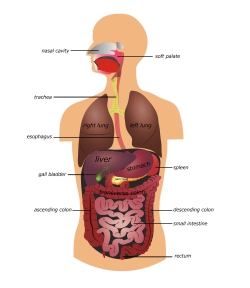Eosinophilic Esophagitis is a mouthful of a word. It is a condition that we are seeing more and more frequently. It is a common cause of difficulty swallowing, as well as heartburn that does not respond to conventional therapy. Eosinophilic esophagitis is sometimes abbreviated as EoE.
To understand Eosinophilic Esophagitis, we need to review two different words. We will take the second word, esophagitis, first. The esophagus refers to the food tube that connects our mouth to our stomach. Any time an organ in the body becomes inflamed, we attach an “itis” to it. Esophagitis then is inflammation of the esophagus. There are many things that can cause inflammation of the esophagus such as acid reflux or certain infections.
The other word is eosinophil. To understand eosinophil, we need to look at the cells in our blood. Part of our blood is made up of white cells that circulate through the body and help fight infection and perform other, protective functions. One type of white cell is called the eosinophil. These particular cells are involved in our body’s allergic reactions. For example, eosinophils are activated in people with asthma.
So, when we put these two words together; eosinophilic esophagitis is an inflammation of the esophagus generated by eosinophils. The eosinophils infiltrate into the wall of the esophagus and can then create certain problems. Eosinophilic esophagitis has also been referred to as Allergic Esophagitis. Eosinophilic esophagitis is seen throughout the world. It is often found in children but is well-described in adults as well. It appears to be more common in males.
Symptoms
Common symptoms of Eosinophilic Esophagitis are difficulty swallowing food, heartburn that doesn’t respond to typical therapy with antacids, or food lodging in the esophagus. Very young children may develop weight loss and difficulty feeding. It can also yield chronic abdominal pain.
Cause
We do not fully understand Eosinophilic Esophagitis. We suspect it is an allergic reaction that develops in those prone to allergies. Environmental factors and genetics likely play rolls. For example, if one identical twin develops EoE, there is a 60% chance the other will develop it compared to 35% between non-identical twins. It is more common in males so hormones may also be a factor. Regardless of the trigger, we know that the eosinophil cells are “turned on” and become active in the esophagus where they normally do not reside.
Diagnosis
The diagnosis is most often made by a history of difficulty swallowing, particularly in a younger person. Endoscopy is usually done to confirm the diagnosis. Endoscopy is a procedure where a small, flexible scope is passed into the mouth and down the esophagus while the person is lightly sedated. There are some features of the esophagus that can be seen at endoscopy to suggest eosinophilic esophagitis. These include “furrows”, narrow, long, linear channels down the esophagus. Another feature is a series of thin, concentric rings. Small, white plaques, which are dense collections of eosinophils, can also be seen. More importantly is what is seen after biopsies. When a biopsy of the esophagus is taken in someone with Eosinophilic Esophagitis and examined under the microscope, one sees an increase in the number of eosinophils. It is important that the person looking at the biopsy specimen understands the patient’s history and also the location of the biopsy. Other disorders can produce eosinophils of the esophagus, such as reflux disease and inflammatory bowel disease.
Treatment
There is still much to learn about the best treatment for eosinophilic esophagitis. It is important to try and find an underlying cause if allergy is suspected. Sometimes, a person will have a known food allergy and this food should be avoided until it is clear if the particular food allergy is associated with the symptoms. Common foods associated with Eosinophilic Esophagitis include egg, milk protein (whey and casein), soy, wheat and corn. Because of these potential associations, often times these foods are eliminated from the diet and then slowly reintroduced to determine if there is a correlation between the food and the symptoms. Wheat or the milk proteins, whey and casein, seem to be the most common identified food triggers. Allergy testing can also be carried out to help guide diet changes. Acid suppression with any number of medications is often a first line approach. It is not always effective but is generally safe and may help some people. When there is a narrowing in the esophagus, sometimes a dilation is performed.
When people do not respond to diet changes or acid suppression, sometimes steroids are used. Fluticasone (Flovent) and budesonide (Pulmicort) are inhaled steroids that are used in asthma. They can be used for patients with Eosinophilic Esophagitis. Instead of inhaling the steroid, however, the steroid is swallowed with a small amount of water. Oral steroids, such as prednisone and other immunosuppressant medications, have also been found to be effective but the risk and benefits of this approach need to be weighed individually and discussed with your physician.
Finally, a recently approved medication, dupilumab (Dupixent) is FDA approved to treat EoE. It blocks two proteins in our immune system, IL-4 and IL-13, that are involved in the disease. The medication is delivered by injection beneath the skin once a week. Early studies shows that it can be very effective.
Summary
There is still much to learn about eosinophilic esophagitis, but it appears to be increasing in incidence and is a common cause for people, young and old, with difficulty swallowing food. The symptoms may be controlled with either acid suppression or identifying a triggering food group. Endoscopy is often used to diagnose the disorder based on the number of eosinophils on biopsy but can also be used to follow a response to treatment. Elimination diets can be effective. Other treatments include acid suppression, swallowed steroids in the form of swallowed Fluticasone or budesonide or an injection medicine, dupilumab.
